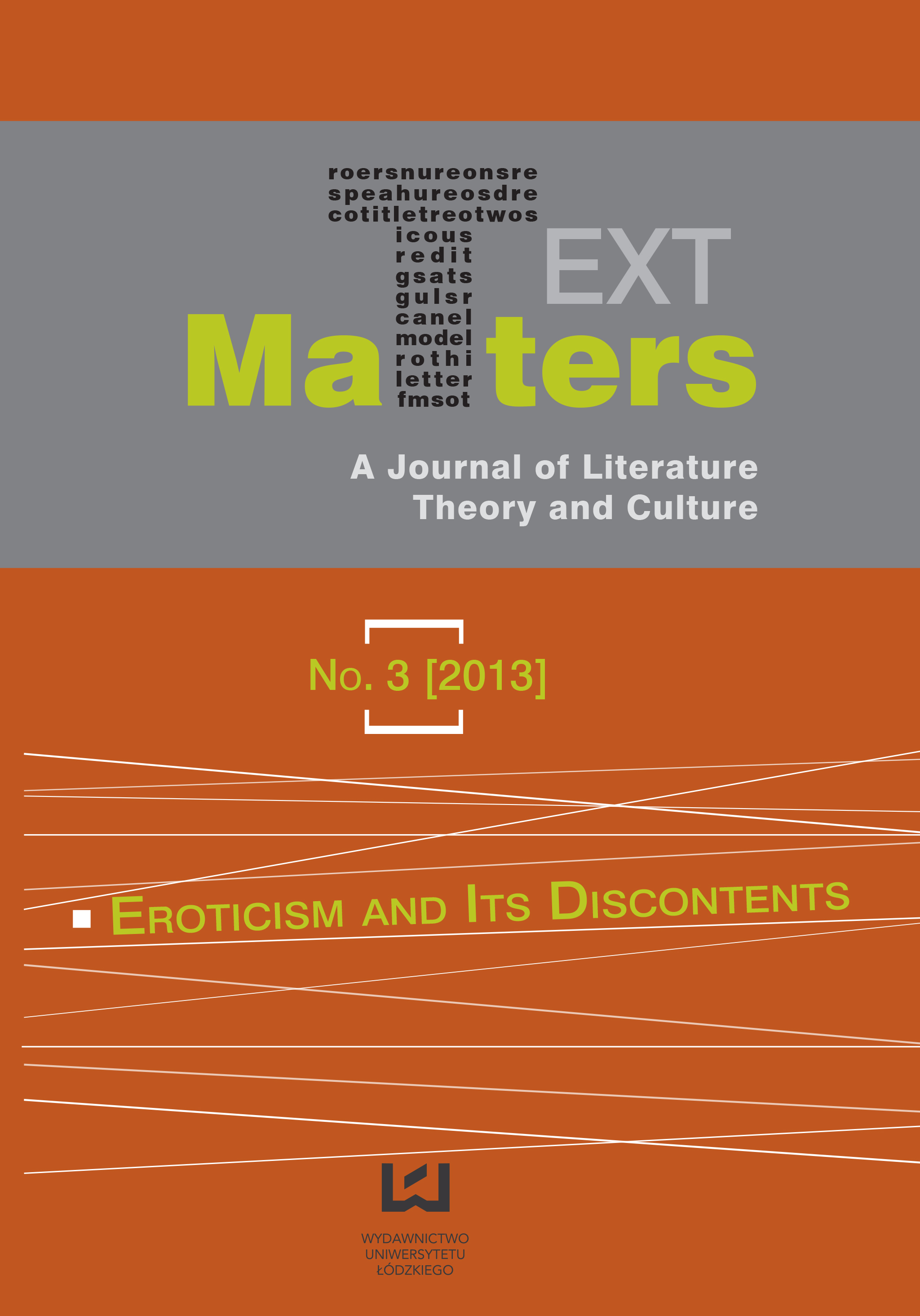“I cluppe and I cusse as I wood wore”: Erotic Imagery in Middle English Mystical Writings
DOI:
https://doi.org/10.2478/texmat-2013-0026Abstract
The mutual influences of the medieval discourse of courtly love and the literary visions of divine love have long been recognized by readers of medieval lyrical poetry and devotional writings. They are especially visible in the affinities between the language used to construct the picture of the ideal courtly lady and the images of the Virgin Mary. Praises of Mary’s physical beauty, strewn with erotic implications, are an example of a strictly male eroticization of the medieval Marian discourse, rooted in Bernard of Clairvaux’s allegorical reading of the Song of Songs, where Mary is imagined as the Bride of the poem, whose “breasts are like two young roes that are twins” (Cant. of Cant. 4:5). Glimpses of medieval female erotic imagination, also employed to express religious meanings, can be found in the writings of the mystical tradition: in England in the books of visions of Margery Kempe, in the anonymous seers of the fourteenth century, and, to some extent, in Julian of Norwich. Though subdued by patriarchal politics and edited by male amanuenses, the female voice can still be heard in the extant texts as it speaks of mystical experience by reference to bodily, somatic and, sometimes, erotic sensations in a manner different from the sensual implications found in the poetry of Marian adoration. The bliss of mystic elation, the ultimate union with God, is, in at least one mystical text, confidently metaphorized as an ecstatic, physical union with the human figure of Christ hanging on the cross.
Downloads
References
Astell, Anne W. The Song of Songs in the Middle Ages. Ithaca, NY: Cornell UP, 1995. Print
Google Scholar
Bernard of Clairvaux. On the Song of Songs. Vol. 2. Cistersian Fathers Series. Trans. Kilian Walsh. Kalamazoo, MI: Cistersian, 1976. Print
Google Scholar
Bynum, Caroline Walker. Fragmentation and Redemption: Essays on Gender and the Human Body in Medieval Religion. New York: Zone, 1991. Print
Google Scholar
The Cloud of Unknowing. Ed. James Walsh. New York: Paulist, 1982. Print
Google Scholar
Coakley, Sarah. “Gregory of Nyssa.” The Spiritual Senses. Perceiving God in Western Christianity. Ed. Paul L. Gavrilyuk and Sarah Coakley. Cambridge: Cambridge UP, 2011. 36–55. Print
Google Scholar
Dreyer, Elizabeth A. Passionate Spirituality. Hildegard of Bingen and Hadewijch of Brabant. Mahwah, NJ: Paulist, 2005. Print
Google Scholar
Farina, Lara. Erotic Discourse and Early English Religious Writing. New York: Palgrave-Macmillan, 2006. Print
Google Scholar
Foucault, Michel. L’Histoire de la sexualité. 3 vols. Gallimard: Paris, 1984. Print
Google Scholar
Gavrilyuk, Paul L., and Sarah Coakley, eds. The Spiritual Senses. Perceiving God in Western Christianity. Cambridge: Cambridge UP, 2011. Print
Google Scholar
Gregory of Nyssa. Commentary on the Song of Songs. Ed. and trans. Casimir McCambley. Brookline: Hellenic College, 1987. Print
Google Scholar
Hadewijch. The Complete Works. Ed. and trans. Columba Hart. New York: Paulist, 1980. Print
Google Scholar
Hugo of St. Victor. “Explicatio.” Patrologia Latina 196. C406. Ed. Jacques Paul Migne. Paris, 1864. Print
Google Scholar
Julian of Norwich. The Shewings of Julian of Norwich. Ed. Georgia Ronan Crampton. Kalamazoo, MI: Medieval Institute, 1994. N. pag. TEAMS Middle English Text Series. Web. 15 June 2011
Google Scholar
Lewis, C.S. The Allegory of Love. A Study in Medieval Tradition. Oxford: Oxford UP, 1936. Print
Google Scholar
Lochrie, Karma. Margery Kempe and Translations of the Flesh. Philadelphia: U of Pennsylvania P, 1991. Print
Google Scholar
Logan, F. Donald. A History of the Church in the Middle Ages. New York: Routledge, 2002. Print
Google Scholar
McGinn, Bernard. “The Language of Inner Experience in Christian Mysticism.” Spiritus: A Journal of Christian Spirituality 1.2 (2001): 156–71. Web. 18 June 2011
Google Scholar
McInroy, Mark J. “Origen of Alexandria.” The Spiritual Senses. Perceiving God in Western Christianity. Ed. Paul L. Gavrilyuk and Sarah Coakley. Cambridge: Cambridge UP, 2011. 20–35. Print
Google Scholar
The New Cambridge Paragraph Bible with the Apocrypha: King James Version. Cambridge: Cambridge UP, 2005. Print
Google Scholar
Origen. The Song of Songs. Commentary and Homilies. Trans. R. P. Lawson. Westminster: Newman, 1957. Print
Google Scholar
Petrarcha, Francesco. Canzoniere. Ed. Ugo Dotti. Roma: Donzelli, 2004. Print
Google Scholar
Phipps, William E. “The Plight of the Song of Songs.” Journal of the American Academy of Religion 42.1 (1974): 82–100. Web. 20 June 2011
Google Scholar
Saupe, Karen, ed. Middle English Marian Lyrics. Kalamazoo, Michigan: Medieval Institute, 1997. N. pag. TEAMS Middle English Texts Series. Web. 25 June 2011
Google Scholar
A Talkynk of the Loue of God. Ed. M. Salvina Westra. The Hague: Nijhoff, 1950. Print
Google Scholar
Tallon, Andrew. Head and Heart: Affection, Cognition, Volition as Triune Consciousness. New York: Fordham UP, 1997. Print
Google Scholar
Taylor, Henry Osborne. The Mediaeval Mind; A History of the Development of Thought and Emotion in the Middle Ages. London: Macmillan, 1911. Print
Google Scholar
Tobin, J. Frank. Introduction. The Flowing Light of the Godhead. By Mechthild of Magdeburg. New York: Paulist, 1998. Print
Google Scholar
Weil, Simone. The Notebooks. Vol. 1. New York: Routledge, 2004. Print
Google Scholar
Downloads
Published
How to Cite
Issue
Section
License
Copyright (c) 2013 This content is open access.

This work is licensed under a Creative Commons Attribution-NonCommercial-NoDerivatives 4.0 International License.













